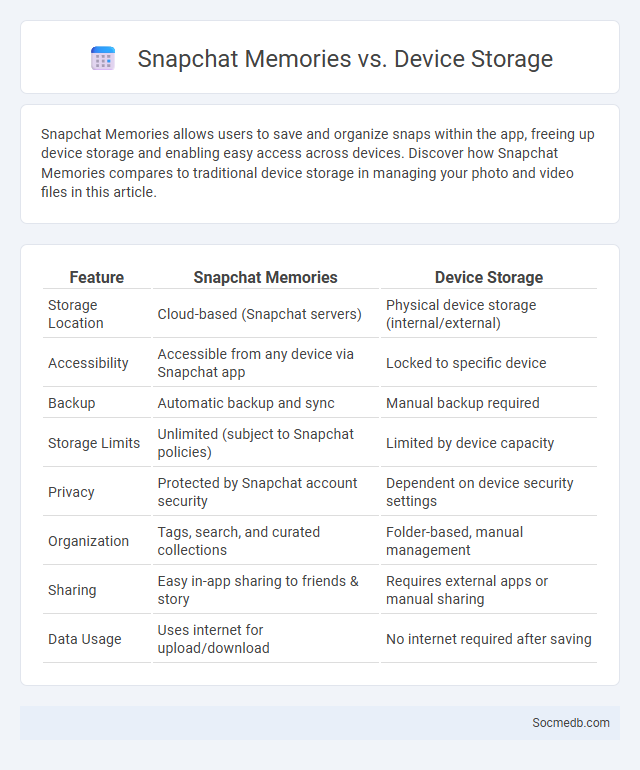
Photo illustration: Snapchat Memories vs Device Storage
Snapchat Memories allows users to save and organize snaps within the app, freeing up device storage and enabling easy access across devices. Discover how Snapchat Memories compares to traditional device storage in managing your photo and video files in this article.
Table of Comparison
| Feature | Snapchat Memories | Device Storage |
|---|---|---|
| Storage Location | Cloud-based (Snapchat servers) | Physical device storage (internal/external) |
| Accessibility | Accessible from any device via Snapchat app | Locked to specific device |
| Backup | Automatic backup and sync | Manual backup required |
| Storage Limits | Unlimited (subject to Snapchat policies) | Limited by device capacity |
| Privacy | Protected by Snapchat account security | Dependent on device security settings |
| Organization | Tags, search, and curated collections | Folder-based, manual management |
| Sharing | Easy in-app sharing to friends & story | Requires external apps or manual sharing |
| Data Usage | Uses internet for upload/download | No internet required after saving |
Introduction to Snapchat Memories and Device Storage
Snapchat Memories is a feature that allows you to save and organize your snaps and stories directly within the app, providing easy access to your favorite moments without relying solely on your device storage. By storing images and videos in Memories, you free up space on your phone while ensuring your important content is backed up securely on Snapchat's cloud servers. Managing device storage efficiently helps maintain optimal performance and makes sharing your saved Memories seamless across different devices.
How Snapchat Memories Works
Snapchat Memories allows you to save snaps and stories privately within the app, where they are stored securely and accessible anytime without appearing in your public story. This feature uses cloud storage to back up your photos and videos, enabling easy organization through customizable folders, making retrieval efficient. Your saved memories can be edited, shared, or archived at your convenience, preserving important moments beyond their usual 24-hour lifespan.
Understanding Device Storage Functionality
Device storage functionality directly impacts social media app performance by managing data locally on smartphones and tablets, including images, videos, and cached content, enabling faster load times and smoother user experiences. Efficient storage allocation ensures social media platforms store temporary data effectively, reducing lag and preventing app crashes during high-traffic interactions such as live streaming and real-time messaging. Understanding how device storage interacts with cloud syncing is essential for optimizing offline access to social media content and managing storage limits without compromising app responsiveness.
Key Differences Between Snapchat Memories and Device Storage
Snapchat Memories securely stores your Snaps and Stories within the app, allowing instant access and easy sharing, while device storage physically holds media files on your smartphone's internal or external memory. Memories use cloud-based encryption specific to Snapchat, ensuring enhanced privacy and backup, whereas device storage is vulnerable to data loss if your device is damaged or lost. Understanding these distinctions helps optimize how you manage and preserve your digital moments effectively.
Privacy and Security: Snapchat Memories vs Device Storage
Snapchat Memories encrypts your saved snaps and stories on secure cloud servers, offering enhanced privacy controls like password protection and selective sharing options. In contrast, device storage saves your photos locally, exposing them to risks such as unauthorized access or data loss if your phone is compromised. Protecting Your content is more reliable with Snapchat Memories' built-in security features, ensuring your private moments stay safe even if your device is lost or hacked.
Accessibility: Retrieving Memories on Snapchat vs Device Storage
Accessing memories on Snapchat offers a seamless, cloud-based experience that preserves your moments securely and allows retrieval from any device with internet access. In contrast, device storage depends on local memory, which may limit accessibility if your phone is lost or damaged. Your choice impacts how easily and reliably you can revisit important memories across platforms.
Storage Limits and Capacity Comparison
Social media platforms vary significantly in storage limits and capacity, affecting how much content you can upload and retain. Instagram restricts photo and video uploads to specific file sizes and durations, while YouTube allows longer videos but imposes overall channel storage limits based on account status. Understanding these differences helps you manage your digital content efficiently across platforms.
Data Backup and Recovery in Snapchat vs Device Storage
Snapchat stores your chats and memories on cloud servers, enabling efficient data backup and recovery in case of device loss, unlike relying solely on device storage which is vulnerable to hardware failure. Your Snapchat data is encrypted and synced automatically, providing seamless restoration compared to manual backups on device storage. Prioritizing Snapchat's cloud backup ensures your social interactions and media remain secure and accessible regardless of device status.
Pros and Cons of Using Snapchat Memories
Snapchat Memories offers the advantage of easily saving and organizing snaps and stories, allowing users to revisit moments without losing them in the ephemeral nature of the app. This feature enhances content management and sharing flexibility, making it convenient for personal archiving and storytelling. However, storing snaps in Memories raises privacy concerns, as saved content may be more vulnerable to unauthorized access or data breaches compared to temporary snaps.
Choosing the Best Option: Snapchat Memories or Device Storage
Choosing between Snapchat Memories and your device storage depends on your priorities for accessibility and privacy. Snapchat Memories offers cloud-based backup with easy access across devices and automatic sorting, while device storage provides greater control and offline availability. Consider your need for instant sharing and security to decide which option suits Your digital organization best.
 socmedb.com
socmedb.com